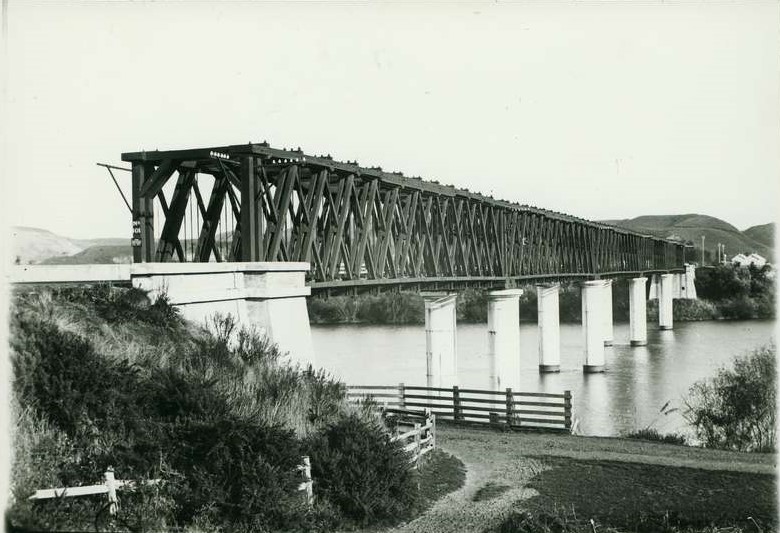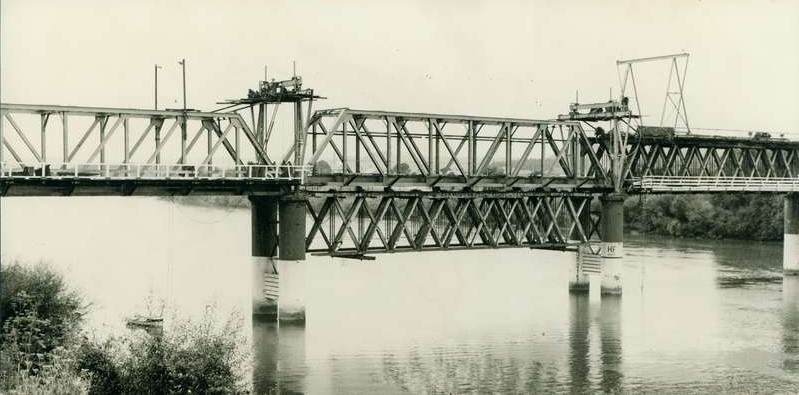Collection Stories
By Karen Wrigglesworth
The Aramoho railway bridge has been an important local structure and integral to the Wellington to New Plymouth line since it opened in May 1877 at a cost of £14,831.
Originally a timber truss design of five spans, each 37 metres in length, the bridge was designed in 1873 by Public Works Department engineers. It was part of a project to construct a national railway network, following the Railways Act 1872. As with much local infrastructure, however, getting the bridge built was not straightforward.
A punt was used to take borings in January 1874 local citizens expressed concerns about restricted river navigation, or as the Wanganui Chronicle editor put it, “Free navigation … is so much more important than the railway”.
By November the same year, it was dubbed the “Bridge of Sighs” because plans to site it and the station two miles out of town essentially bypassed Wanganui. No other settlement had to suffer such indignity. A further insult was that railway authorities refused to fund the Aramoho-to-town line.
In 1875 a rumour suggested Wanganui would extend itself to the bridge before the railway was brought to town. Railway work progressed more rapidly at Napier where the Superintendent was well-connected and vocal.

Whanganui Regional Museum Collection W-ARB-007
The bridge was set on cast iron cylinders and mass-concrete abutments. The end abutments were founded on driven piles of locally-sourced tōtara which were still in perfect condition in 1962. Cylinders were a typical construction method for large railway structures at the time. They were built up from cast iron rings bolted together and filled with concrete after sinking. By May 1876, all but two of the cylinder piers had been sunk.
In June it was confirmed that the railways would appropriate central riverside land for shunting yards, turntables and a station. This saw the closing of many private wharves, replaced by a wharf restricted to railway use.
And in September, a massive boom from the upper section of the girder on the town side of the bridge collapsed. Workmen lifting the item at the time fortunately escaped injury. The accident was caused by a faulty iron ring attached to the top scaffolding (there were five into which tackles were hooked to regulate the purchase). The boom weighed 11 tonnes, which was supposed to be equally distributed among the rings. The other rings held, and the eventual collapse was attributed to stretching of the block tongues by the falling boom. There was a month’s delay while the girder was reconstructed.
In March 1877 the Wanganui Herald editor complained about unsatisfactory progress on the Wanganui-Manawatu line. Work on the Town Extension hadn’t begun. This, despite a promise by the Minister of Public Works in 1875 that the extension was essential and that survey work for the line and central station would soon be underway. The railway was critical to connect the large producing districts around Wanganui with Wanganui Port.
In 1897, an earthquake damaged bolts and severed the unpiled wingwalls from the east-side piled abutments. Pile scour was a concern, but river conditions changed in 1900 and protection became unnecessary.

Wanganui Herald Photograph
Whanganui Regional Museum Collection WRM W-ARB-013
From 1900, heavier steam engines were introduced. Plates were attached to iron bottom chords on the truss spans for strength using an ingenious method, and cylinders were cross-braced for stability.
In 1962, the timber trusses were replaced with steel truss spans due to increased scarcity of precision saw and adze skills, and the heavy cost of maintenance inspections and renewals.
Now, 140 years after being built, the bridge remains in active service.
Written by Karen Wrigglesworth – Whanganui engineer and writer, and research volunteer at the Whanganui Regional Museum (at the time of writing).
This article was originally published in Whanganui Chronicle, November, 2016.






